As Sony headphones continue to gain popularity among audio enthusiasts, users often wonder about the best charging practices to maintain optimal battery health and performance. One common question that arises is whether it is safe to charge Sony headphones overnight. This article delves into the pros and cons of charging Sony headphones overnight, exploring the impact on battery life, potential risks, and recommended charging practices to ensure long-lasting, reliable performance.
- Understanding Lithium-ion Batteries in Sony Headphones:
Most Sony headphones, like many modern electronic devices, are powered by lithium-ion (Li-ion) batteries. These batteries offer several advantages over traditional nickel-based batteries, including higher energy density, lighter weight, and reduced self-discharge rates. Li-ion batteries are also less prone to the memory effect, making them more resilient to partial charging. However, certain charging practices can still affect battery life and overall performance.
- Overnight Charging: The Pros
a) Convenience: Overnight charging is convenient for users who rely on their Sony headphones daily. It ensures the headphones are fully charged and ready for use the next day.
b) Automatic Shut-off: Most Sony headphones are designed with safety features that automatically stop charging when the battery reaches full capacity, preventing overcharging.
c) Quick Charging: Some Sony headphone models support quick charging, allowing users to enjoy several hours of playback with just a short charging period.
d) Deep Sleep Mode: Many Sony headphones have a low-power deep sleep mode, which activates when the battery is fully charged, reducing energy consumption and minimizing the risk of battery damage due to extended charging.
- Overnight Charging: The Cons
a) Long-Term Battery Health: Charging Li-ion batteries to 100% and keeping them at full charge for extended periods can gradually reduce their overall capacity over time. Constant exposure to high voltage can lead to battery degradation, ultimately affecting the total battery life.
b) Heat Generation: Charging generates heat, and when headphones are left plugged in for extended periods, heat can build up and impact battery performance and longevity.
c) Safety Concerns: Although modern headphones are designed with safety features to prevent overcharging, there is still a small risk of electrical issues that could potentially lead to damage or even fire hazards.
- Recommended Charging Practices:
To strike a balance between convenience and battery health, consider the following recommended charging practices for Sony headphones:
a) Partial Charging: Charging your headphones partially, for example, when the battery is low or at around 50%, can help avoid constant exposure to high voltage and extend battery life.
b) Charging Before Use: Charge your headphones before using them rather than leaving them plugged in for an extended period after they are fully charged.
c) Unplug When Fully Charged: If you decide to charge your headphones overnight, unplug them once they reach full capacity to prevent overcharging.
d) Charge in Moderation: Avoid excessive charging or charging too frequently, as this can contribute to battery degradation over time.
e) Store Properly: If you plan to store your headphones for an extended period, ensure they are charged to around 50% before storing them in a cool, dry place, away from direct sunlight.
f) Follow Manufacturer’s Guidelines: Refer to the user manual or product documentation for specific charging recommendations provided by Sony for your headphone model.
- Maximizing Battery Life:
Apart from charging practices, several other factors can influence the overall battery life of Sony headphones:
a) Volume Levels: Playing audio at higher volume levels can consume more power, leading to faster battery drain.
b) Usage Patterns: Continuous music playback, frequent phone calls, and extended use of features like noise-cancellation can also impact battery life.
c) Ambient Conditions: Extreme temperatures, both hot and cold, can influence battery performance.
- Battery Health and Replacement:
Over time, battery performance may naturally degrade. If you notice a significant decrease in battery life or if the battery no longer holds a charge as it used to, it might be time to consider getting the battery replaced through an authorized Sony service center.
Conclusion:
Charging Sony headphones overnight can be convenient but also raises concerns about long-term battery health and potential risks. Lithium-ion batteries used in Sony headphones are more resilient to memory effect, but prolonged exposure to high voltage and heat can still impact their overall performance and longevity. To strike a balance between convenience and battery health, consider partial charging, unplugging when fully charged, and following the manufacturer’s guidelines. Additionally, be mindful of usage patterns and ambient conditions that can influence battery life. By adopting these recommended charging practices, you can enjoy extended battery life and a seamless audio experience with your Sony headphones for years to come.


